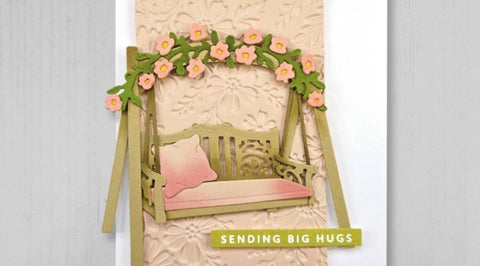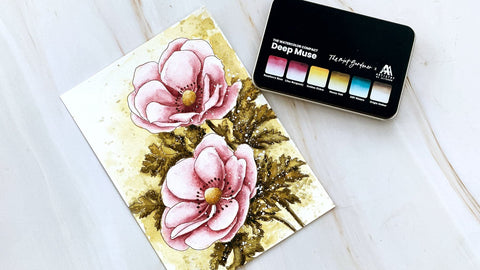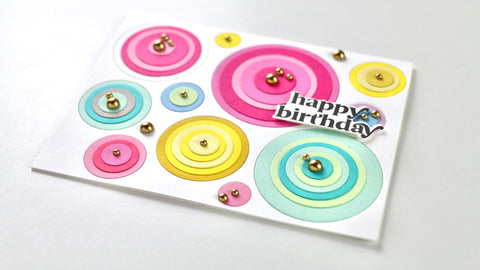5 Surprising Reasons Your Handmade Cards Aren't Turning Out Right (And How to Fix Them)
Last Updated: August 29, 2025
Are you frustrated that your handmade cards never turn out "right"? Tired of your cards never quite living up to your vision? Don't worry, you're not alone! Creating DIY cards can be a fun and rewarding hobby, but it's easy to run into unexpected issues or challenges that can spoil the final result.

To help you overcome these challenges, we've compiled a list of 5 surprising reasons your handmade cards aren't turning out right, along with expert tips on how to fix them.

How to Build a Stamped Background
Let's dive in and unlock the secrets to crafting cards that are both beautiful and professionally polished. Get ready to wow your friends and family with your newfound card making superpowers!

5 Surprising Reasons Your Handmade Cards Aren't “Perfect”
In this quick guide, we'll explore 5 surprising reasons your DIY cards might not be turning out as "perfect" as you'd hoped, and share expert tips to help you overcome these obstacles. Whether you're a seasoned card crafter or just starting out, you're sure to walk away with a better understanding of how to elevate your handmade projects.

1. Incorrect Cardstock Weight
One of the most common mistakes in card making is using the wrong cardstock weight. The weight of the cardstock you choose can have a significant impact on the final outcome of your cards. Using cardstock that is too light can lead to flimsy, easily damaged cards while using cardstock that is too heavy can cause warping and folding issues. Here’s a quick guide to cardstock weights and sizes.

| Expert Tip: Cardstock with a weight of 80-110 lbs is ideal for most card making projects. This weight provides the perfect balance of sturdiness and flexibility, allowing your cards to maintain their shape while still being easy to work with. |

2. Poor Adhesive Choices
Choosing the right adhesive is crucial for ensuring that your handmade cards hold together securely and look professional. Using the wrong adhesive can result in cards that come apart, have bubbling, or fail to stick properly. Read more on how to choose the best adhesives for card making.


| Expert Tip: Most cardmaking experts recommend using glue tape or double-sided adhesive tapes for a secure, smooth finish. These adhesives provide strong, long-lasting bonds and are suitable for a wide range of card making techniques. For more dimension, foam tape is highly recommended. |


3. Lack of Pizzazz
Have you ever created a DIY card that just seemed to be missing that extra spark? The lack of pizzazz can often be attributed to a few key factors. Whether it's the choice of colors, the design layout, or the overall theme, sometimes DIY cards can fall flat in the creativity department. There are plenty of pro tips to help you inject some much-needed pizzazz into your handmade creations!

| Expert Tip: From experimenting with different embellishments to incorporating unique textures and patterns (heat embossing, dry embossing, hot foiling, etc.), there are so many ways to help your cards go from ordinary to extraordinary in no time! |


4. Rushed Stamping Techniques
Stamping is a fundamental aspect of card making, and rushing through this step can lead to a variety of issues such as smudging, off-center images, and other stamping flaws.
| Expert Tip: Take your time when stamping and use a stamping platform for precise placement. Gently pressing the stamp onto the paper will result in crisp, clean impressions without any smudges or imperfections. |

5. Lack of Layering and Dimension
Flat, one-dimensional cards can lack visual interest and fail to capture the recipient's attention. Adding layers and dimension to your handmade cards can make them more visually appealing and offer a tactile experience.

| Expert Tip: Incorporate layered elements, foam adhesives, and other dimensional touches to add depth and visual appeal to your cards. By introducing different textures and elevating certain elements, you can create stunning, eye-catching designs that stand out. |
Watch the video tutorial and learn 3 easy tips for dimensional one layer cards!
Remember, the key to perfecting your craft lies in paying attention to the details, experimenting with new techniques, and never being afraid to step outside your comfort zone. By addressing these common card making issues and applying tips from top crafters, you can elevate the quality and visual appeal of your handmade cards. With the right cardmaking techniques and materials, you'll be creating professional-looking cards in no time. Don't get discouraged by past mistakes – armed with these expert tips, you're ready to take your DIY card making to the next level!

Grab your supplies, put on your creativity cap, and get ready to craft handmade cards that are truly worthy of admiration. Happy card making!
Find more easy card making ideas and tips In the Craft Room! See you there!

















That’s a wonderful tip, Ginger! Thanks for sharing. :)
Might I add, the rule of threes, or odd numbers. It’s more pleasing to the eye. That includes visually separating your card into three sections.
Thank you so much, Cathy Jo! Glad you found it helpful. Happy crafting! :)
Great article!! Thank you!!
Hello, Lucille! Thank you! We hope you’re investing in unique and versatile stamps and dies too. :) Happy crafting!